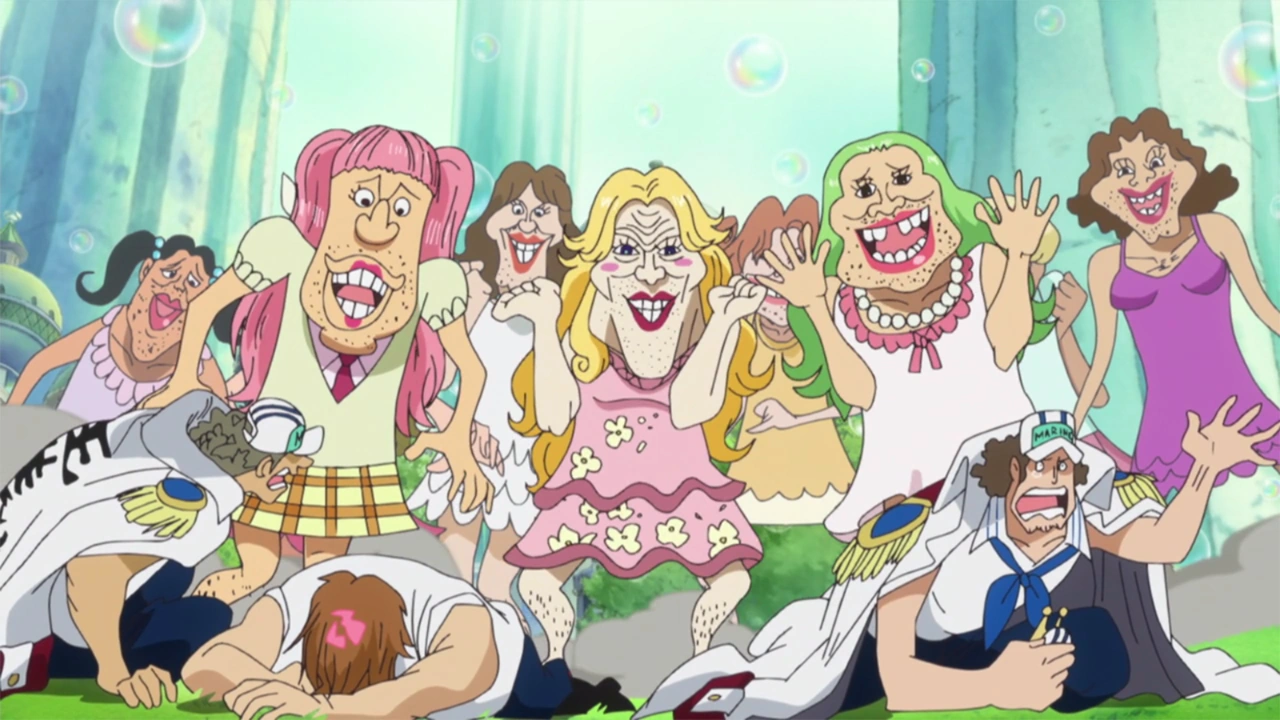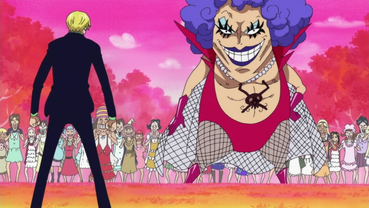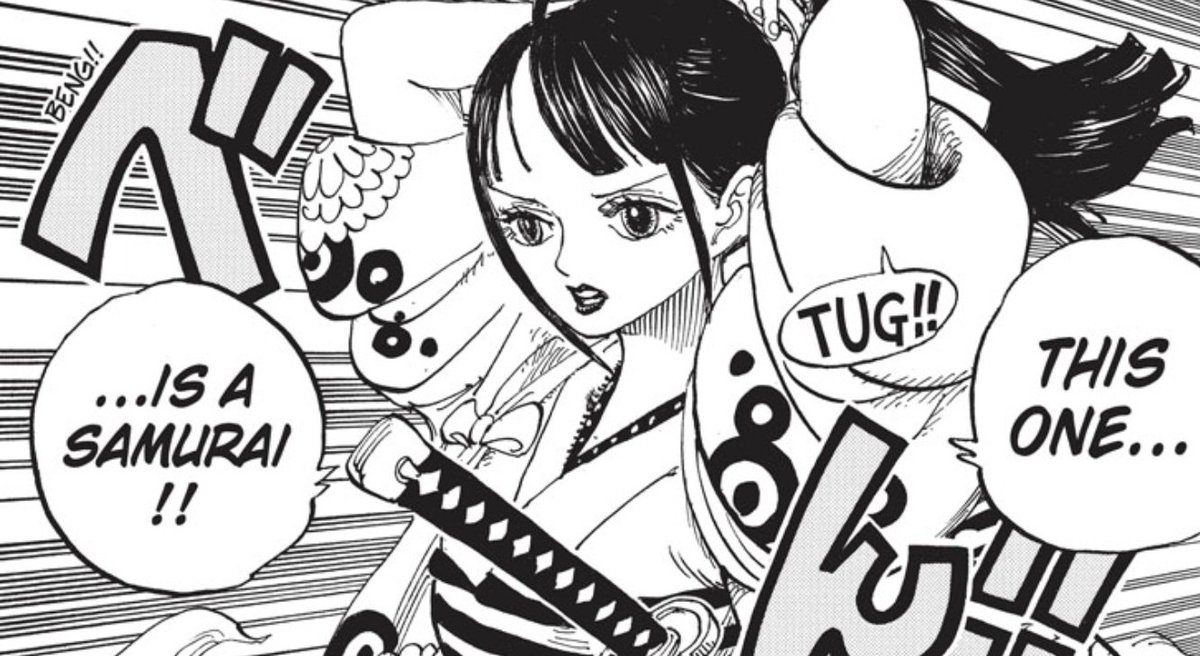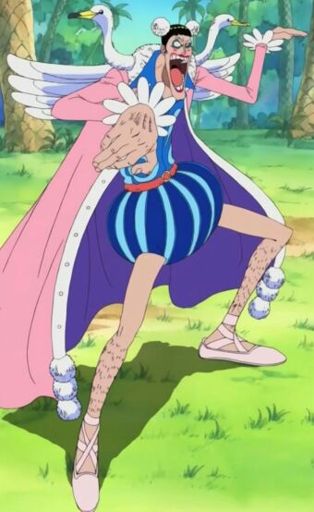 Yeah that’s right, we’re going there. A series as long
running and wide in scale as One Piece has dipped its toes into plenty of ponds
that there are a thousand different perspectives to look at it from, in today’s
case we’re going to look at it in terms of its portrayal of LGBT+ folk. Being a
fan of the series for the better half of my life and being a queer person means
that I have developed plenty of opinions on the series on this subject matter,
and with recent developments means this is an ideal time to discuss this series
through the lens of Queer Theory.
Yeah that’s right, we’re going there. A series as long
running and wide in scale as One Piece has dipped its toes into plenty of ponds
that there are a thousand different perspectives to look at it from, in today’s
case we’re going to look at it in terms of its portrayal of LGBT+ folk. Being a
fan of the series for the better half of my life and being a queer person means
that I have developed plenty of opinions on the series on this subject matter,
and with recent developments means this is an ideal time to discuss this series
through the lens of Queer Theory.
Let us begin with the first technically open Queer character
in the series and the hot button topic that is Bon Clay AKA Mr 2. I say technically
open because upon a reread at no point is his sexuality officially stated in
the series. Now this isn’t unusual seeing as sexuality, romance and everything
in that field have never been a specific focus for the series, to the point
where the series didn’t have its first kiss until nearly 900 chapters in, and
even then that was off-panel. That doesn’t stop the evidence from piling up,
his fighting style is called ‘Okama Kenpo’ (Okama being a Japanese term for homosexual),
and then there is of course the over-abundance of Queer Coding going on with
the…everything in his design. Thus comes the first major criticism with the way
series creator Eiichiro Oda represents queer people, the heavy reliance on
stereotyping, including dressing in drag, perverted personalities, and being
rather over the top and disrespecting personal boundaries, which sadly is the
typical portrayal of gay men in a lot of Japanese media, the idea of gay men
being aggressors, looking to forcefully “convert” the straight men they find
attractive. Now, Bon Clay himself isn’t necessarily a precursor for these
stereotypes, but many more would go on to fill this role, particularly those of
‘Okama Land’ who do in fact fulfil these harmful portrayals.
That being said, depending on who you ask, Bon Clay could
arguably be considered a strong representation of a gay character. Like I said,
his sexuality is never outright discussed in the series, and no one ever berates
him for the way he dresses or behaves. There is always a debate amongst people over
what qualifies as good representation of gay characters in stories that aren’t
exclusively about their sexuality, how much of a role should their sexuality
play? Should they be a character who just happens to be gay or should it act
somehow as a defining feature? While there is no question on Bon Clay’s
sexuality, it is yet to play an actual role in the story, but that doesn’t mean
he’s lacking in depth. Bon Clay is a character introduced as a villain but with an energetic and positive attitude to the point where he actually develops a strong friendship with our protagonists that he ends up sacrificing himself for our protagonist Luffy in one of the most heartbreaking scenes. His sense of loyalty and steadfast dedication to protect those he cares about, overcoming his fears and fighting with a unique form of martial arts is arguably his most defining characteristics over his sexuality. He’s a character with a cool fighting style, a well
defined personality and strong relationships built without his identity as a gay
man even mattering, yet at the same time it’s clearly not a feature about him
that’s hidden and he’s very proud of the fact.
Upon rereading the Alabasta arc for this blog I also noticed
early on there is discussion of Bon Clay saying he is neither man nor woman, he
is both and neither at the same time. This is used as the explanation to why he’s
the only member of his organisation that doesn’t have a partner. Now is this confirmation
that the character is Gender Fluid or Non-Binary or something else along those
lines? I doubt it, I believe this is either a mistranslation by Viz Media or is
Oda writing something not understanding the implications, again falling back on
the clichés of gay men identifying more as feminine simply because they are gay.
Though Oda’s reliance on these tropes would only become worse with the next
batch of queer characters, that being Ivankov and Momoiro Land, also known as Kamabakka
Ōkoku, which translates to “full of transvestites”…*sigh*
Ivankov and his team are arguably the most controversial
character amongst this discussion, as not only do they represent the more
negative aspects of Bon Clay but far more heightened, emphasizing the
perversion, ugliness and creep factors often associated with this negative
stereotyping, but in terms of gender identity things go so much farther in the
world of uncomfortable. Ivankov has the ability to alter people on a genetic
level, specifically change their hormones, and he uses this ability to alter
people’s bodies, for the most part he only uses it on his allies who wish to
change their sex to whatever their preference is, however there is at least one
confirmed usage where he uses it on someone against their will and forcefully
changes their sex from male to female. In terms of Queer Theory this is what
would be called a ‘Big fucking mess’.
Much like Bon Clay, there is also plenty more to Ivankov
outside of their sexuality and gender identity, they have interesting powers, contribute
to the story, have well defined relationships amongst a variety of characters
and they are never judged for their identity. It is also worth noting Oda's reasoning for including Ivankov in the first place. Bon Clay's voice actor Kazuki Yao once took Oda to a crossdressing bar filled with drag queens and Oda was such a big fan that he based the character off real life drag queen Norio Imamura, who would eventually go on to play the role in the anime. Unfortunately there are still
quite a few red flags being flown with this character and his gang in terms of
representation, they highlight the worst tropes that could be used to represent
queer characters that some would say there’s no coming back from this, they dug
their grave, and for many this could be the single defining element that
prevents them from wanting to get into One Piece, and ya know what? I can’t
blame them. Oda's choices with these characters does not come from a place of mallace, but admiration, and this was his genuine attempt at positive representation. This doesn't excuse him for his errors, but I also think it is worth noting and hopefully it was this exact criticism he recieved that went on to influence his next major attempt.
What convinced me to discuss this subject matter now is the
introduction of a very distinct character for One Piece, and that would be O-Kiku,
aka Kikunojo of the Lingering Snow, One Piece’s first transgender character. Kiku
is a samurai and one of the Nine Red Scabbards, 9 of the greatest warriors in
the land of Wano. What makes Kiku such an interesting character for many people
especially in terms of representation is simply how she goes against convention
for Oda’s usual representation. Physically she’s not exaggerated at all in her
appearance and her gender identity was actually addressed by the characters, it
was only in a single panel of Chopper saying “You’re a man?” and Kiku responds “This
one is a woman at heart” and that was the end of any kind of questioning in her
identity, they accepted it and moved on. She highlights all of the best
elements of the Queer characters before but with none of the negative
stereotyping that held the others back, arguably making her the best portrayal so
far.
That being said, there’s a reason why I’m discussing this
character now rather than waiting for the end of the story arc when we’ll have
a full picture of her as a character, and that is because in case you can’t
tell, every other queer character comes with a “but”, something holding them
back or a negative aspect that makes them relatively harmful. Though many of us
welcomed Kiku with open arms and praised Oda for introducing the character, and we can only hope this is an example of his growth as a person from Ivankov to Kiku, we
are all waiting for that ‘but’, for something about Kiku or someone’s reaction
to Kiku to make us all groan and feel uncomfortable. The current frontrunner is
Sanji being disgusted and freaking out, as he has a history of doing so.
Speaking of Sanji, this brings me to the final topic of discussion
when it comes to One Piece and Queer Theory, and that would be Head-canons. Fan
theories, desires or even clues from Oda himself to suggest at other characters
sexualities and who could potentially identify as something other than
heterosexual. Now granted One Piece has
a huge fanbase and probably every character has had their sexuality questioned
by someone at some point, especially considering most character don’t have
their sexuality even hinted at which leaves a whole lot of room for people to
insert whatever preference they would like in there, so we’re going to leave
this to just some of the bigger head-canons and my perspective on them.
Sanji has always been an interesting one to analyse under
this lens because he’s one of the few characters that has a definitive attraction
to one or more genders, seeing as one of his defining personality traits is that
he is in love with most women and constantly lusts after them, to the point of
grand perversion that really holds the character back for a lot of people. Even
more so than that is the fact he is clearly homophobic, as his time with
Ivankov & co would lay evident, the thought of Queer men disgusts him - which
makes it really awkward that I consider him my second favourite character in
the series - but even this hasn’t stopped him from having fan theories made
about him that he is actually Bisexual and his outward homophobia is in reality internalised self-hatred over his own sexual identity. This personally is not a
theory I’m a fan of as the idea of homophobia being active denial over ones own
personal sexuality I find to be a cheap plot device, also people suggest that Sanji
and Zoro secretly have feelings for each other that they disguise as hatred is
also a cheap plot device. The two of them having a legitimate hatred for each other but also a respect and understanding of one another that they still work well as a team is a far more interesting dynamic than just primary school logic of bullying your crush. Then there is Nami who many view as a Lesbian with
the main portion of evidence being her clear lack of interest in men and
preference to be in the company of women as she is far more comfortable, honest
and happy to be amongst them, but really isn’t that just how most people work?
Have you ever met men? We suck.
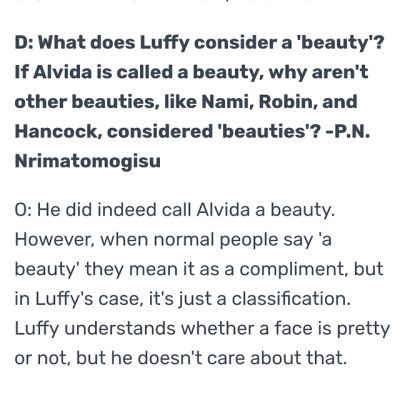 Finally there is Luffy, who by far has the most evidence to
suggest this head-canon is actually canon, and would also be the most
interesting if it would finally be confirmed. Many view Luffy as asexual and
there is plenty to back this up, for one would be the actual words from Oda
himself who has said that the idea of relationships completely disinterests Luffy
and he has never shown any open attraction to anyone, in fact it’s been used as
an actual plot device. The character of Boa Hancock is supposedly the most
attractive woman in the world to the point where literally everyone is
attracted to her, man, woman, animal…except for Monkey D Luffy. At one point
Luffy describes Alvida as “A beautiful woman” but Oda expanded on this by
saying that while Luffy acknowledges what beauty is, it’s not something that
matters to him, so when he describes someone as beautiful, it’s more along the
lines of him stating a fact rather than paying a compliment. Again, this is a
case where it comes with a ‘But, that being the old cliché that asexual
characters are often portrayed as idiots and it implies they are simply too
stupid to be attracted to people, and stupid is definitely one of Luffy’s
defining characteristics. Even with that being the case, if this were to
actually be confirmed, Luffy would be the most popular character in fiction to
represent asexuals, and considering how well written of a character he is I’d
hope most people would see this as a positive thing, but obviously that comes
down to personal preference, almost every character discussed here could easily
be seen as either a positive or negative representation (Some more so than
others).
Finally there is Luffy, who by far has the most evidence to
suggest this head-canon is actually canon, and would also be the most
interesting if it would finally be confirmed. Many view Luffy as asexual and
there is plenty to back this up, for one would be the actual words from Oda
himself who has said that the idea of relationships completely disinterests Luffy
and he has never shown any open attraction to anyone, in fact it’s been used as
an actual plot device. The character of Boa Hancock is supposedly the most
attractive woman in the world to the point where literally everyone is
attracted to her, man, woman, animal…except for Monkey D Luffy. At one point
Luffy describes Alvida as “A beautiful woman” but Oda expanded on this by
saying that while Luffy acknowledges what beauty is, it’s not something that
matters to him, so when he describes someone as beautiful, it’s more along the
lines of him stating a fact rather than paying a compliment. Again, this is a
case where it comes with a ‘But, that being the old cliché that asexual
characters are often portrayed as idiots and it implies they are simply too
stupid to be attracted to people, and stupid is definitely one of Luffy’s
defining characteristics. Even with that being the case, if this were to
actually be confirmed, Luffy would be the most popular character in fiction to
represent asexuals, and considering how well written of a character he is I’d
hope most people would see this as a positive thing, but obviously that comes
down to personal preference, almost every character discussed here could easily
be seen as either a positive or negative representation (Some more so than
others).
In conclusion, representation within the One Piece world may
not be vast, but what is there is incredibly loaded in discussion, in both the
positives and the negatives, however it is great to see the portrayal of queer
characters has only gotten more positive as the series has gotten older and we
can only hope it continues in this direction, so what I’m trying to say is
this: Oda, please don’t fuck up Kiku?
-Danny
